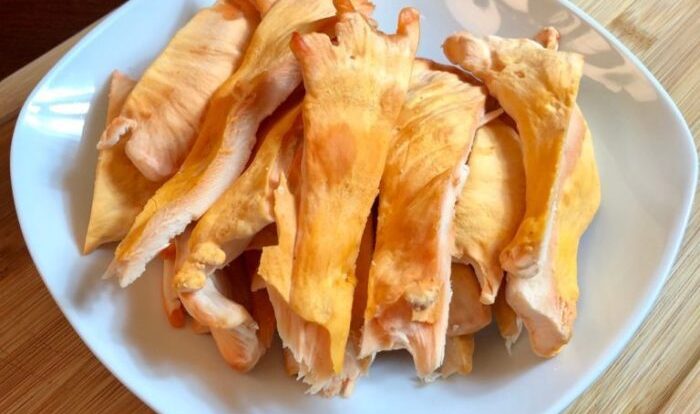
Chicken of the woods recipe – Dive into the world of chicken of the woods, a wild mushroom renowned for its vibrant colors and delectable taste. From foraging techniques to culinary applications, this comprehensive guide will equip you with everything you need to enjoy this forest delicacy.
With its high nutritional value and unique flavor profile, chicken of the woods is a versatile ingredient that can transform any dish into a culinary masterpiece.
Recipe Variations: Chicken Of The Woods Recipe

Chicken of the woods is a versatile mushroom that can be prepared in a variety of ways. Its unique flavor and texture make it a popular choice for vegetarians and meat-eaters alike.One of the most popular ways to cook chicken of the woods is to sauté it in butter or olive oil.
This method brings out the mushroom’s natural flavor and gives it a slightly crispy texture. Chicken of the woods can also be roasted, grilled, or fried.No matter how you choose to cook it, chicken of the woods is a delicious and nutritious meal.
It is a good source of protein, fiber, and antioxidants.
Flavor Variations
The flavor of chicken of the woods can be enhanced by using a variety of seasonings, herbs, and sauces. Some popular options include:
- Garlic
- Onion
- Thyme
- Rosemary
- Sage
- Lemon juice
- White wine
- Soy sauce
- Barbecue sauce
These are just a few of the many ways to enjoy chicken of the woods. With its versatility and delicious flavor, it is a mushroom that is sure to please everyone at the table.
Nutritional Value and Health Benefits
Chicken of the woods is a nutritional powerhouse, boasting an impressive array of nutrients. It’s an excellent source of protein, fiber, and vitamins.
Protein
- Rich in protein, chicken of the woods provides essential amino acids necessary for muscle growth and repair.
- Compared to other mushrooms, it contains a higher protein content, making it a valuable plant-based protein source.
Fiber
- High in fiber, chicken of the woods aids in digestion and promotes a feeling of fullness.
- Its fiber content helps regulate blood sugar levels and supports a healthy digestive system.
Vitamins
- Chicken of the woods is a rich source of vitamins, including vitamins B1, B2, B3, and vitamin C.
- These vitamins are crucial for energy production, cell growth, and immune function.
Antioxidant Properties
- Chicken of the woods contains antioxidants that protect cells from damage caused by free radicals.
- These antioxidants may help reduce the risk of chronic diseases such as heart disease and cancer.
Immune-Boosting Effects
- Certain compounds found in chicken of the woods have been shown to enhance immune function.
- It may help stimulate the production of white blood cells, which fight off infections.
Recommended Serving Size and Contraindications
The recommended serving size of chicken of the woods is around 4-6 ounces per meal. However, it’s important to note that some individuals may experience allergic reactions to mushrooms. If you have any concerns, consult with a healthcare professional before consuming chicken of the woods.
Craving a taste of the wild? Check out this chicken of the woods recipe for a unique and flavorful meal. This edible mushroom offers a meaty texture that’s perfect for grilling, roasting, or sautéing. With its versatility and health benefits, it’s a must-try for any adventurous foodie.
Identification and Foraging Techniques

Chicken of the woods, a polypore mushroom, boasts distinctive features that make it easily identifiable. It typically forms large, shelf-like clusters with bright orange to yellow coloration. The texture of its flesh is tender and moist, while the underside exhibits a white or cream-colored pore surface.
When foraging for chicken of the woods, it’s crucial to be aware of its habitat and identifying characteristics. These mushrooms often grow at the base of oak trees, particularly in moist, shady areas. Look for clusters that resemble chicken breasts or corals, with vibrant hues that range from orange to yellow.
Distinguishing Features
- Large, shelf-like clusters
- Bright orange to yellow coloration
- Tender and moist flesh
- White or cream-colored pore surface
Responsible Foraging
Responsible foraging practices are essential for the conservation of chicken of the woods and other wild mushrooms. Avoid overharvesting by only taking what you need, and always leave some behind for wildlife and future growth. Additionally, never uproot the entire mushroom; instead, use a sharp knife to carefully cut it from the base.
Culinary Applications and Pairing Suggestions

Chicken of the woods is a versatile mushroom with a wide range of culinary applications. Its unique flavor and texture make it a great addition to a variety of dishes.
One of the most popular ways to cook chicken of the woods is to stir-fry it. This method allows the mushroom to retain its crispiness while absorbing the flavors of other ingredients. Chicken of the woods can also be added to soups and stews, where it will add a meaty flavor and texture.
If you’re looking for a unique and delicious mushroom dish, look no further than chicken of the woods . This wild mushroom has a meaty texture and a savory flavor that makes it a great substitute for chicken. Whether you’re sautéing it, roasting it, or grilling it, chicken of the woods is sure to impress your taste buds.
For a lighter option, try adding chicken of the woods to salads. Its mild flavor will complement other salad ingredients without overpowering them.
Pairing Suggestions
Chicken of the woods pairs well with a variety of ingredients. Some popular pairings include:
- Vegetables: Chicken of the woods goes well with a variety of vegetables, such as onions, peppers, carrots, and celery.
- Grains: Chicken of the woods can be added to grains, such as rice, quinoa, and pasta, to create a hearty and flavorful dish.
- Sauces: Chicken of the woods can be paired with a variety of sauces, such as soy sauce, teriyaki sauce, and barbecue sauce.
Preparation and Storage Techniques
Before cooking chicken of the woods, it’s crucial to prepare it properly to ensure the best flavor and texture. This involves cleaning, cutting, and storing it correctly. Additionally, preserving techniques like drying, freezing, and pickling can extend its shelf life and preserve its quality.
Cleaning
To clean chicken of the woods, use a soft brush or a damp cloth to remove any dirt or debris. Avoid washing it with water, as this can make it soggy and reduce its flavor. If there are any tough or woody parts, simply trim them off.
If you’re looking for a culinary adventure, look no further than the chicken of the woods recipe . This woodland delicacy has a tender texture and a slightly sweet flavor that pairs well with a variety of seasonings and cooking methods.
Whether you prefer a simple sauté or a hearty soup, this mushroom will add a touch of the forest to your plate.
Cutting
Chicken of the woods can be cut into various shapes and sizes depending on your preference. For stir-fries or salads, cut it into thin strips. For roasting or grilling, larger chunks or slices work well. Remember to remove any tough or fibrous parts.
Storing
Fresh chicken of the woods can be stored in the refrigerator for up to 3 days. Wrap it loosely in a damp paper towel and place it in an airtight container. For longer storage, you can dry, freeze, or pickle it.
Drying
Drying chicken of the woods is a great way to preserve it and enhance its flavor. Cut it into thin slices and spread them on a baking sheet lined with parchment paper. Bake at the lowest oven setting (around 175°F or 80°C) for several hours or until completely dry and crispy.
Freezing
Freezing is another option for preserving chicken of the woods. Cut it into desired sizes and place it in freezer-safe bags or containers. It can be stored in the freezer for up to 6 months.
Pickling, Chicken of the woods recipe
Pickling chicken of the woods adds a tangy and savory flavor. Cut it into bite-sized pieces and submerge it in a brine solution made with vinegar, water, salt, and spices. Store the pickled chicken of the woods in a sealed jar in the refrigerator for up to 2 weeks.
Tips for Maximizing Shelf Life and Quality
- Store chicken of the woods in a cool, dry place away from direct sunlight.
- If it starts to develop mold or an off smell, discard it immediately.
- When drying chicken of the woods, make sure it is completely dry before storing it to prevent spoilage.
- Frozen chicken of the woods should be thawed in the refrigerator overnight before using.
- Pickled chicken of the woods can be stored in the refrigerator for up to 2 weeks.
Final Review
Whether you’re a seasoned forager or a curious home cook, this guide has something for everyone. Embrace the wild flavors of chicken of the woods and create dishes that will tantalize your taste buds.
FAQ Section
What are the key identifying features of chicken of the woods?
Chicken of the woods is characterized by its bright orange or yellow color, ruffled texture, and fan-shaped growth pattern.
How can I safely forage for chicken of the woods?
When foraging, look for chicken of the woods growing on decaying hardwood logs or stumps. Always consult a field guide or experienced forager to confirm identification.
What are some popular culinary applications for chicken of the woods?
Chicken of the woods can be sautéed, grilled, roasted, or fried. It pairs well with vegetables, grains, and sauces.